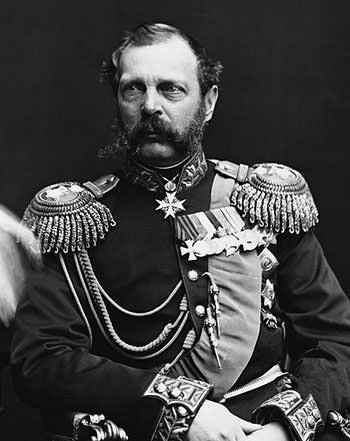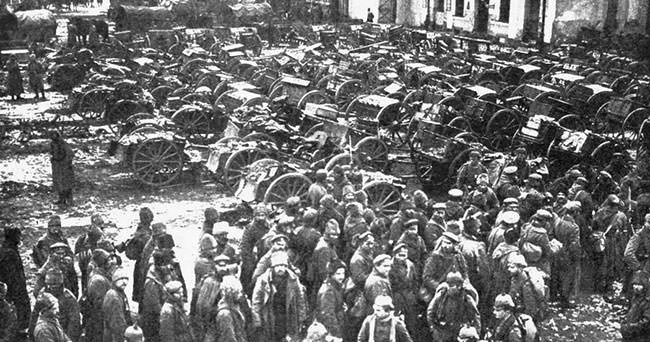Nicholas II was the Tsar of Russia from 1894 to 1917. He had an eventful reign which started with the Khodynka Tragedy and ended with the February Revolution. Here are 10 interesting facts about the last Emperor of Russia whose downfall brought an end to three centuries long reign of Romanov Dynasty.
#1 HIS GRANDFATHER WAS KNOWN AS ALEXANDER THE LIBERATOR
Nicholas II was born Nikolai Aleksandrovich Romanov in Pushkin, Russia, on May 18, 1868. At the time of his birth, his grandfather Alexander II was the Emperor of Russia. Alexander II was the most successful Russian reformer since Peter the Great and was known as Alexander the Liberator. Nikolai was the eldest of six children born to Alexander Alexandrovich, heir to the Russian empire and Maria Feodorovna, Princess of Denmark before marriage.

#2 HE ASCENDED THE THRONE WHEN HE WAS 26
Alexander II was assassinated on 1 March 1881 and Nicholas witnessed his death as he was present at the Winter Palace, where his grandfather was brought after being attacked. Nicholas’ father Alexander Alexandrovich ascended the throne as Alexander III the same year. Alexander III died at the age of forty-nine on 1 November 1894, leaving the twenty-six year old Nicholas as Tsar of Russia.

#3 HIS CORONATION WAS MARRED BY THE KHODYNKA TRAGEDY
Nicholas II was officially coronated on 26 May 1896 at the Uspensky Cathedral, Kremlin. The next day a large festival was held at Khodynka Field as it was the only place large enough to hold all the citizens of Moscow. A rumor that there was not enough for everyone led to a stampede, killing more than a thousand people. Despite being reluctant, Nicholas II attended a ball that night to not strain relations with France. Attending the ball made the public view him as being oblivious to their grief.

#4 NICHOLAS II WAS NOMINATED FOR THE NOBEL PEACE PRIZE
Nicholas II proposed and promoted the famous Hague Convention of 1899. The conference was held to end the arms race and solve international disputes peacefully. Although it was not successful due to distrust among major powers, still it was among the first formal statements of the laws of war and war crimes. Due to his efforts, Nicholas II was nominated for the Nobel Peace Prize in 1901.

#5 RUSSIA WAS HEAVILY DEFEATED BY JAPAN DURING HIS REIGN
Russo-Japanese War began in 1904 with the Japanese attack on the Russian fleet in Port Arthur. Nicholas II neglected the cost of war and maintained that the Japanese were racially inferior and militarily weak. It was due to his wish that Russia remained in the war despite suffering multiple defeats. It was after the annihilation of the Russian fleet in the Battle of Tsushima that Nicholas pursued peace. The war ended in 1905 but humiliation at the hands of Japan and severe losses were seen as shortcomings of the Romanov autocracy.
#6 HE WAS HELD RESPONSIBLE FOR BLOODY SUNDAY
On Sunday, 22 January 1905, unarmed demonstrators led by Father Georgy Gapon marched towards the Winter Palace to present a petition to Nicholas II regarding problems faced by the working class like wages, working hours and working conditions. Soldiers of the Imperial Guard fired on the demonstrators. Although official records said only 92 people died, it is estimated that more than a thousand were dead or wounded. Though he didn’t order the shooting, Nicholas II was widely held responsible for Bloody Sunday.

#7 HE FORMED THE STATE DUMA DUE TO THE REVOLUTION OF 1905
Bloody Sunday led to a strike movement that spread throughout the country and is considered the start of the Revolution of 1905. The strike paralyzed Russia, many demonstrations were held and thousands of people were killed, the Black Sea Fleet mutinied and an uncle of Nicholas was killed by a revolutionary’s bomb. To appease the people Nicholas ordered the formation of the State Duma, a legislative body to represent the public. However the Tsar retained his autocratic powers.

#8 HE WAS RESPONSIBLE FOR RUSSIA PARTICIPATING IN WW1
Nicholas approved the Russian mobilization of August 1914, which marked the beginning of Russia’s involvement in the First World War. Russia had a pre-war regular strength of 1.4 million soldiers and mobilization added another 3.1 million. However in every other respect Russia was hugely unprepared for war as compared to Germany. Russia suffered staggering losses in the war with 3.3 million Russians being killed. Nicholas II was blamed for pushing Russia into a war from which it had little to gain and for his incompetent leadership.

#9 NICHOLAS II WAS EXECUTED ALONG WITH HIS FAMILY
By early 1917, Russia was on the verge of total collapse with massive rioting and rebellions and soaring prices. The February Revolution forced Nicholas II to relinquish his authority marking the end of the Russian Empire and the Romanov dynasty, which ruled Russia for three centuries. On 17 July 1918, Tsar Nicholas II, his wife Tsarina Alexandra and their five children were executed by Bolsheviks led by Yakov Yurovsky under the orders of the Ural Soviet. They were shot by revolvers in the basement.

#10 NICHOLAS II WAS CANONIZED BY THE RUSSIAN ORTHODOX CHURCH
In 1981, Nicholas and his immediate family were recognized as martyred saints by the Russian Orthodox Church Outside Russia. On 14 August 2000, the Russian Orthodox Church within Russia canonized them as passion bearers, a category used to identify believers who, in imitation of Christ, endured suffering and death at the hands of political enemies. Due to this Nicholas II is known as Saint Nicholas the Martyr. He is also called Nicholas the Bloody due to Khodynka Tragedy, Bloody Sunday and the innumerable executions during his reign.


excellent post, very informative. I’m wondering why the opposite specialists of this sector do not notice this. You should continue your writing. I’m confident, you’ve a huge readers’ base already!
Thanks for your appreciation.
This is not. Helpful